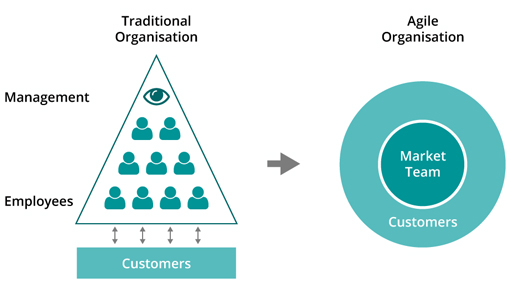Chris Dealy explains why your contact centre might be better off without hierarchical silos.
Most companies still have a hierarchical organisation structure. At the top is the CEO, then the rest of the C-level, then middle management and finally the employees who work on the front line.
The organisation is usually depicted as a pyramid, with the boss at the top and the employees at the bottom. The bigger the company, the more tiers of management seem to be needed.
This form of organisation goes back centuries. It takes in elements of Adam Smith’s Division of Labour (18th century) and FW Taylor’s Scientific Management (early 20th century). These theories both assume that efficiency and productivity are improved by increasing specialisation, reducing individual autonomy and doing work in a rigid, repetitive way that requires minimal creativity or initiative.
The result? A company that is fragmented into departments, each inward-looking and focused on its own rigidly defined goals.
How often does Marketing ‘forget’ to tell Operations about a new launch?
Those of us who have worked in call centres will have experienced the dis-economies of a silo organisation. For example, how often does Marketing ‘forget’ to tell Operations about the launch of a new advertising campaign? But the problems of the traditional hierarchical and segmented organisation don’t end there.
To be blunt, in today’s post-industrial, knowledge-based economy, Taylorism simply doesn’t work. A rigid silo organisation is woefully inefficient.
At injixo, we pride ourselves on our innovation. Now in 2015, we have transformed our organisation into one that is flat and agile.
Every employee is the boss
Every employee is empowered to act independently in the best interests of the company and our customers. We have introduced a completely flat organisation without hierarchy or job titles, adopting the #NoManagement principle.

In an Agile Organisation, every employee is empowered to act independently in the best interests of the company.
Our people don’t wait for instructions from superiors, perform tasks by the book every time or have to create complex workarounds for out-of-date processes. Teams are trusted to work together to find the best possible solutions to problems – and to put them straight into action. Suggestions for improvement go from brainwave to implementation quickly, without waiting for a long approval process to run its course.
Focus on results not departments
Until quite recently, we ran our company in hierarchical silos just like everybody else. We believed that more specialisation would result in even more efficiency. For example, we thought that it wasn’t good enough to have the role of Consultant; we needed Technical Consultants, Junior and Senior Application Consultants, Project Managers, Pro Services Directors and so on.
But then we realised that any role definition limits flexibility to respond to the needs of the business and its customers. For example, an Application Consultant might have been qualified as a Project Manager or have had a successful Sales background – but he was not allowed to jump in as and when needed because the task did not fit his role definition. This lack of flexibility and agility was bad for customers – and ultimately for the company.
Apart from certain central functions like Finance, we have completely abolished departmental structures and hierarchy. For example, in each region, we simply have a Market Team. This team is empowered to do what is needed to delight existing customers and attract new ones.
Depending on the nature of the task, the team member best qualified makes the decisions and takes care of delivery. The job is done by the most appropriate employee – not the one with the most appropriate job title. For years we have been explaining the pooling efficiencies that flow from having a multi-skilled workforce. Now we are practising what we preach.
Slow decision-making creates frustrating delays for customers
Hierarchy leads to slow decision-making, which in turn creates frustrating delays for customers; skilled employees have to wait for a ‘manager’ to make a decision, even though they have the best knowledge with which to make the right choice. The Market Team organisation means that we can be more agile when reacting to customer demands by making decisions better and faster.
This new system is better because all employees in Market Teams communicate directly with customers without needing to go through, e.g. a Project Manager. Team members can react flexibly to find the best solution based on first-hand knowledge of the customer’s situation, having openly discussed the issue within a multi-disciplined team.
Rules are limited to such essentials as handling sensitive data

Chris Dealy
Of course there are rules, but they are limited to essential technical details such as the handling of sensitive data. But everything else is decided collaboratively. We no longer even have holiday allowances – Market Team members work together to ensure that holidays can be taken when desired without creating an under-staffing situation.
It is also faster because decisions can be made without the need for unnecessary layers of management. Unlike in hierarchical organisations, there is no management pyramid and the idea of an ‘escalation path’ makes no sense.
Why would it? No one understands customers better than the Market Team members who interact with them every day. Team members are empowered to deliver the best solution without the need for management approval.
With thanks to Chris Dealy at injixo
Author: Megan Jones
Published On: 6th May 2015 - Last modified: 17th Jun 2024
Read more about - Archived Content, Chris Dealy, Peopleware








